Para os países que falam Inglês
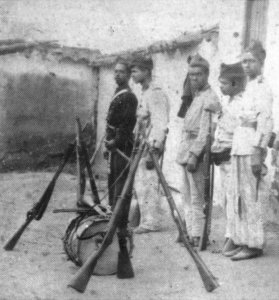
Brazilian Army
soldiers with their rifles model Comblain -http://www.francisco.paula.nom.br
“…the jagunços then
collected all the corpses that were lying here and there, decapitated them, and
burned the bodies; after which they lined the heads up along both sides of the
highway, at regular intervals, with the faces turned toward the road., as if
keeping guard. Above these, from the tallest shrubbery, they suspended the
remains of the uniforms and equipment, the trousers and multicolored dolmans,
the saddles, belts, red-striped kepis, the capes, blankets, canteens, and
knapsacks.
“The barren,
withered caatinga now blossomed forth with an extravagant-colored
flora: the bright red of officers’ stripes, the pale blue of dolmans, set off
by the brilliant gleam of shoulder straps and swaying stirrups.
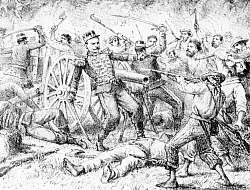
The fight in
the backlands of Bahia – http://www.saojoseonline.com.br
“There is one
painful detail that must be added to complete this cruel picture: at one side
of the road, impaled on a dried angico[31] bough,
loomed the body of Colonel Tamarindo.
“It was a
horrible sight. Like a terribly macabre manikin, the drooping corpse, arms and
legs swaying in the wind as it hung from the flexible, bending branch, in these
desert regions took on the appearance of some demoniac vision. It remained
there for a long time.
“And when,
three months later, a fresh expeditionary force set out for Canudos, this was
the scene that greeted their eyes: rows of skulls bleaching along the roadside,
with the shreds of one-time uniforms stuck up on the tree branches round about,
while over at one side — mute protagonist of a formidable drama — was the
dangling specter of the old colonel.”[32]
While in
the sertão the epic deeds of Canudos were sung in poems where the
undertakings became legendary, in the capital the government was not able to
figure it out: Canudos was an impoverished village, not even on the map, and
yet it had managed to be a match for entire regiments, putting them in check.
The state resorted to inventing tales of political conspiracies, but began to
seriously worry. It feared that little known sertão from which men
armed for revenge emerged from every province converging on Canudos to join the
fight. The university student Euclydes da Cunha wrote about this: “the jagunço…
could do only what he did do — that is, combat and combat in a terrible
fashion, the nation which, having cast him off for three centuries almost,
suddenly sought to raise him to our own state of enlightenment at the point of
the bayonet, revealing to him the brilliancy of our civilization in the
blinding flash of cannons.”[33]
The resolute
men of the sertão had found the place for their struggle: a village
of huts with the appearance of a citadel. The state was forced to face the mute
and tenacious hostility of those who knew quite well what the nation demanded
of them: submission and resignation. Being neither submissive nor resigned,
they would not allow themselves to be dominated.
In social war,
the principle of war that postulates the annihilation of the enemy knows its
most complete application, its conclusion, if you will. What is at stake in
wars between nations is complex. It is essentially political, as is the stake
in wars of national liberation. It doesn’t necessarily require the annihilation
of the enemy. Rather it aims to impose a political will on one’s adversary and
to thus create through the tools of war the conditions for negotiating with
him. In this case, war is the continuation of politics by other means, as Carl
von Klauswitz noted. In the other case, it demands the total and definitive
destruction of the enemy. What is at stake is social: the suppression or the
maintenance of servitude. There is no middle course.
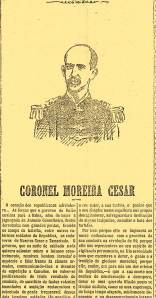
Note the
newspaper “O Paiz”, in Rio de Janeiro, April 8, 1897, on the death of colonel
Moreira César
For the
insurgent, it is a matter of putting an end to his slavery and there is no
compromise possible on such an essential matter. For the master, it is a matter
of safeguarding his social position, his privileges, and his status. No consideration
external to the war itself is thus able to impede and moderate its violence. It
is war in the pure, original state; it is what it originally was, pure
negativity.
In a dangerous
situation like social war, errors due to hesitation, vacillation and
kind-heartedness are precisely the worst of things. Every consideration
external to the purpose of the war, the total defeat of the enemy, would be
fatal.
Since the use
of physical force in one’s interests does not, in fact, exclude the cooperation
of intelligence, those who ruthlessly avail themselves of this force without
backing away in the face of any bloodshed, any moral restriction will have an
advantage over their enemy, if the latter does not act on the same basis.
Violence, or
rather physical violence (since moral violence does not exist outside of the
concept of the State and Law, whose violence is that of the victor that imposes
its will) thus forms the means. The end is overthrowing the
enemy.
Social war is
absolute brutality that does not tolerate weakness. Ignoring this element
because of the repugnance it inspires would be a waste of energy, not to
mention a mistake. Showing indecision at a certain point in relation to the
predetermined aim means leaving the initiative to the enemy, a mistake for
which one will pay quite dearly.
There can be
no negotiation. Peace is either the return to slavery or the end of slavery.
Whichever it is, it is the destruction of one of two possibilities.
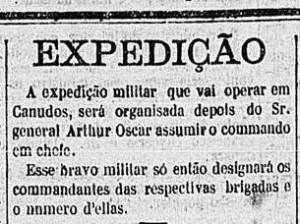
After the
defeat of the forces under the command of Colonel Moreira César, the newspaper
notes “GAZETTE NEWS”, in Rio de Janeiro, April 10, 1897, comments on the new
expedition Brazilian military forces under the command of General Arthur Oscar
On April 5,
1897, General Arthur Oscar organized the forces for the fourth expedition: six
brigades in two columns. Battalions were conscripted from throughout the land,
for national unity, the sacred union against the internal enemy.
The two
columns were supposed to converge on Canudos. The one commanded by Arthur Oscar
would go by the Monte-Santo road, while the other, under the command of
Savaget, would pass through Jeremoabo, coming together to launch the attack at
the end of June. But as they neared Canudos, both encountered some
difficulties. Savaget’s column was attacked twice between Cocorobó and Canudos.
The losses were heavy, and the general was wounded. “As always, the sertanejos were
taking the edge off victory by unaccountably rising up again from the havoc of
a lost battle. Beaten, they did not permit themselves to be dislodged.
Dislodged at all points, they found shelter elsewhere, at once conquered and
menacing, fleeing and slaying as they fled in the manner of the Parthians[34].”[35]
Things got
even more serious for General Arthur Oscar, who had reached the peak of Favela
that overlooked the village. After a rapid victory to conquer the position, he
found himself a prisoner, besieged by those he had just beaten. He had to
request aid from the Savaget column. On July 1, the jagunços attacked
the encampments, and some tried to reach the “Killer”, the siege cannon (a
Witworth 32) that bombed Canudos. They didn’t manage to do this.
The army found
itself in a critical situation. Cut off from its supplies, it could neither
advance nor retreat. “At the same time the rifle fire all around made it plain
to all that this was in truth a siege to which they were being subjected, even
though the enemies’ lines in the form of numerous trenches were spread out
laxly, in an undefined radius, over the slopes of the hill… The bold and unvarying tactics of the jagunços were
nowhere more clearly revealed than in the resistance which he offered even
while retreating, as he sought every means of shelter which the terrain
afforded… On the one hand were men equipped for war by all the resources of
modern industry, materially strong and brutal, as from the mouths of their
cannons they hurled tons of steel on the rebels; and on the other hand, were
these rude warriors who opposed to all this the masterly stratagems of the
backwoodsman. The latter willingly gave their antagonists his meaningless
victories, which served merely as a lure; but even as the ‘victor’, after
having paved with lead the soil of the caatingas, was unfurling his banners and
awakening the desert echoes with his drumbeats, they, not possessing these
refinements of civilization, kept time to triumphal hymns with the whines of
bullets from their shotguns.”[36]
Two weeks later, supplies managed to
arrive and the troops launched an attack on the village. They were defeated
with considerable losses. In the army and the government, there was dismay.
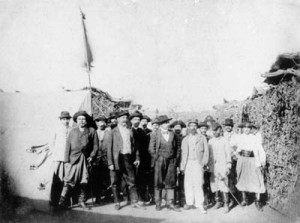
High command
of the fourth and final expedition in Canudos. In the foreground, from left to
right, the generals-Brigadier João Barbosa da Silva, commander of the first
column, Artur Oscar de Guimarães Andrade, general-in-chief of the expedition,
Carlos Eugênio de Andrade Guimarães, brother of Arthur Oscar and commander of
the 2nd column, Major Salvador Pires de Carvalho Aragon, commander of the 5th
Police in Bahia, and two officers of the 1st Cavalry regiment. Foto de Flávio
de barros, 1897 – http://www.scielo.br
A new brigade,
the Girard brigade, was hastily formed in Queimadas, consisting of one thousand
forty-two soldiers and sixty-eight officers. It set off on August 3 to supply
Arthur Oscar’s army with men and provisions. On the 15th it was attacked
and lost ninety-one blockheads, for which it earned the mocking epithet, the
nice brigade.
The government
now understood that it was no longer a question of making an assault against a
village, but of organizing a genuine military campaign of several weeks, if not
several months, with the aim of completely surrounding it. It understood that
the war would be long and hard and that it needed to supply itself with the
necessary tools.
Marshall
Bittencourt was put in charge of the campaign. Two supplementary brigades
arrived from Bahia and formed a division. A regular convoy service for
Monte-Santo was organized. The army no longer risked being cut off from its
rear and could thus be installed in a trench war. The long strangulation of
Canudos had begun.
On September
7, Calumby road was opened, allowing the siege to come together.
On September
22, Antonio Conselheiro died.
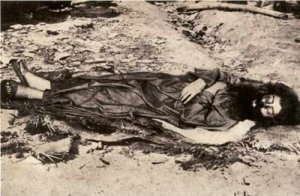
Body of
Antônio Conselheiro. Photo of Flávio de Barros –
http://blogdainsegurancapublica.blogspot.com.br
The fighting
resumed more fiercely around Canudos. The inhabitants discovered the spirit of
initiative. With an astonishing outflanking maneuver, the skirmishes reached
all the enemy’s positions, striking the entire front line, trench by trench.
At a single
stroke, they unexpectedly got past every point of the front. They were beaten
and driven back. Then they launched themselves against the nearest trenches.
Again beaten and pushed back, they directed themselves against those that
followed and went on this way. Even though unsuccessful, their assaults were
unremitting, forming an immense ring-around-the-rosy dance before the troops.
“Those who,
only the day before, had looked with disdain upon this adversary burrowing in
his mud huts, were now filled with astonishment, and as in the evil days of
old, but still more intensely now, they felt the sudden strangling grip of
fear. No more displays of foolhardy courage. An order was issued that the
bugles should no longer be sounded, the only feasible call to arms being that
which the foe himself so eloquently gave…
“In short, the
situation had suddenly become unnatural…
“The battle
was feverishly approaching a decisive climax, one that was to put an end to the
conflict. Yet this stupendous show of resistance on the part of the enemy made
cowards of the victors.”[37]
Extraído do blog: "Tok de História" do historiógrafo e pesquisador do cangaço Rostand Medeiros

Nenhum comentário:
Postar um comentário